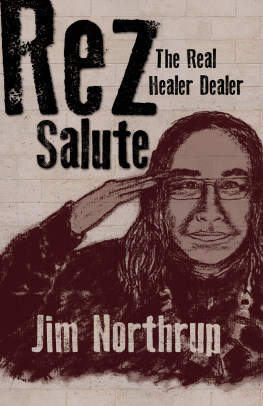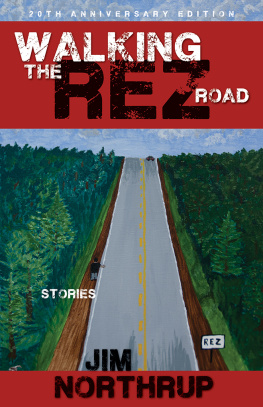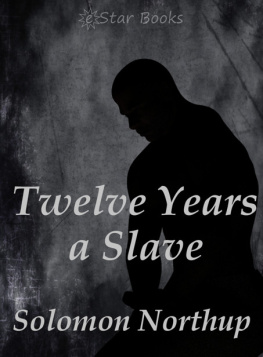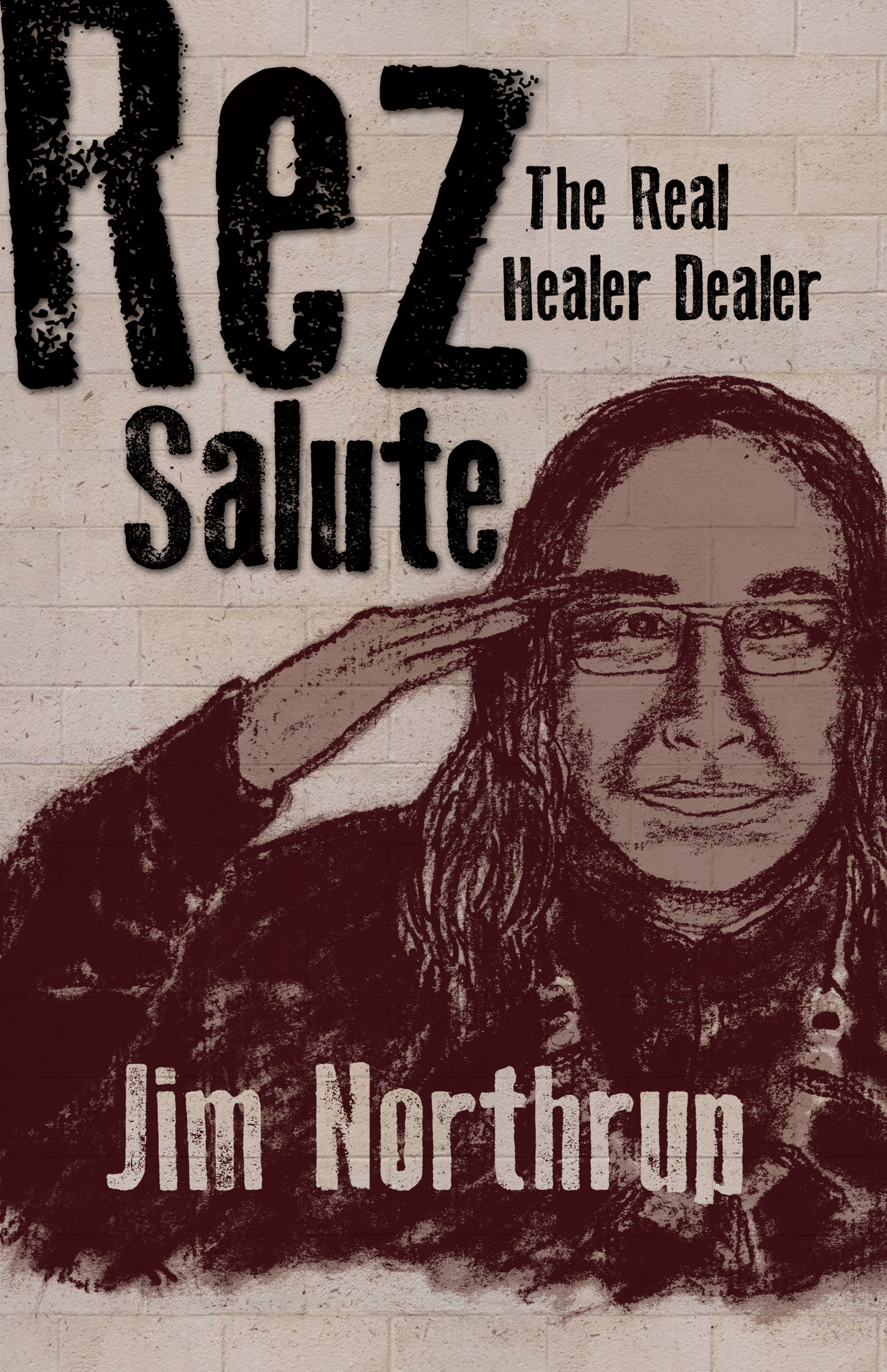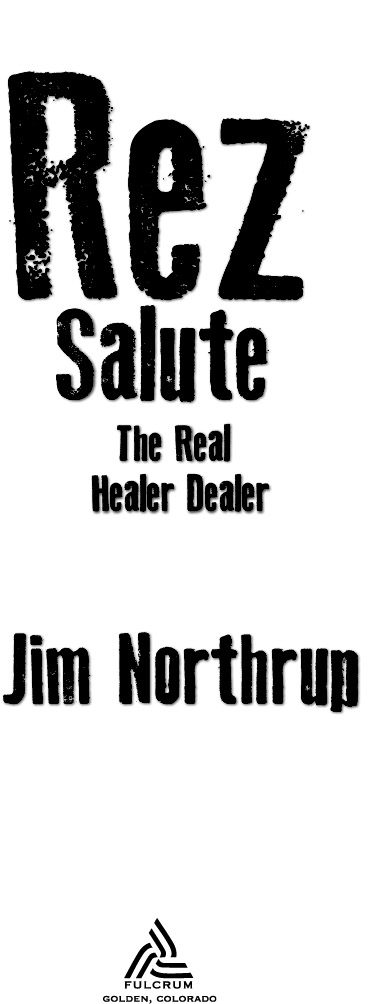Text 2012 Jim Northrup
All rights reserved. No part of this book may be reproduced or transmitted in any form or by any means, electronic or mechanical, including photocopying, recording, or by an information storage and retrieval systemexcept by a reviewer who may quote brief passages in a reviewwithout permission in writing from the publisher.
Library of Congress Cataloging-in-Publication Data
Northrup, Jim, 1943
Rez salute : the real healer dealer / Jim Northrup.
p. cm.
ISBN 978-1-55591-762-3 (pbk.)
1. Northrup, Jim, 1943- 2. Ojibwa Indians--Biography. 3. Ojibwa Indians--Social life and customs. 4. Fond du Lac Indian Reservation (Minn.)--Social life and customs. 5. Ojibwa wit and humor. I. Title.
E99.C6N68 2012
305.897--dc23
2012015997
Printed in the United States of America
0 9 8 7 6 5 4 3 2 1
Design by Jack Lenzo
Fulcrum Publishing
4690 Table Mountain Dr., Ste. 100
Golden, CO 80403
800-992-2908 303-277-1623
www.fulcrumbooks.com
To Umpa Owaastewii and Giiwedin Noodin
Contents
Foreword
Ishgonigan Anamikan: Rez Salute
Rez Salute! The title suggests standing up, taller than usual, taking off your hat, and looking once in each direction: east, south, north, and west. Ishgonigan Anamikan! Ahow! Ahow! Ahow! Ahow! In Anishinaabemowin, the language Jim Northrup uses like a strong rope to cast an anchor into the future, Rez Salute is Ishgonigan Anamikan . Ishgonigan is a word that means the thing after, the leftovers, the remains. Jim invites readers to experience his Rez as a maamakaaj place, where days are sometimes easy, sometimes entertaining, and always worth remembering. What Jim does is share his reverence for history, for stories, and for the place where he has centered his voice for more than half a century and where the voices of his relatives stretch into the distant past and the faraway future. Native American fiction and nonfiction is sometimes assigned a tragic ending in which the subject disappears into the sunset, merging with the land that was the object of colonial desire. Jim offers an alternative to this type of ending. His book has no bowed rider at the end of the trail. It is a proud salute to many nations, those to which he belongs and those he visits and considers united by traditions of humor, storytelling, and survival.
Anishinaabe Syndicated , the first collection of Jims Fond du Lac Follies column, takes readers from 1989 to 2001. It coveres the early years of Jims career and included the defense of sovereign rights, the creation of casino culture, and the simultaneous loss of and struggle to revitalize the Anishinaabe language. Rez Salute , the second collection of the same column, picks up the trace of lessons and stories in 2002 and spans another decade. Readers will recognize the same characters, the same shores and trees, the same nation and politicians, the same seasons and traditions. Yet Rez Salute resonates the way a bell rung many years might, the way an older eagle might circle land he knows well.
Bears still track through town, but Sawyer has a new community center for storytelling, healing, and gathering. At the casino, where Jims wife, Pat, won the finicky but fabulous 64 Corvette Sting Ray, things are getting more commercial, but the buffet is amazing and the new hotel is helpful when visitors to Northrup Road are too numerous. And the visitors do occasionally overflow. The World Headquarters of the Fond du Lac Follies has always been global, but this book documents the way it has changed from a chance destination where an unknown journalist got his start to the place pilgrims find an award-winning poet, columnist, and novelist. Jim still recounts the significant elections on and off the Rez, but he also finds himself, and his friends and family, connecting with Hollywood. In 2006, an entire crew showed up and cast a few characters (and his fire pit) in a scene. Although he seasons the years with his inimitable humor and provocative questions, his representation of these times is important. These chapters are not Jims memoirs; they are the wisely edited recollection of significant events in Anishinaabe history. Jims version of many events stands as counterpoint to versions presented by mainstream media. As non-Native and Native historians return to these years, his words will be a valuable resource for understanding how he saw the world as both a member of the Fond du Lac Band of Lake Superior Chippewa and a Marine who served the United States in Vietnam.
Beyond the changing history of nations, Jim writes of seasonal and generational cycles. Ricing and work in the sugar bush happen again and again, but the babies become the kids who become the masters of these arts eventually. In 2002 he writes, My grandson Ezigaa led the way into the woods. He carried the drill. Right away he started doing the maple tree dance. By 2009 he starts the season with a good-well trained crew... my sons, Jim, Matthew, Joe, Aaron Ezigaa, and Calvin... also my nephew Kris and daughter-in-law Jackie. His family is growing and his years of patient teaching pay off as he explains, My part was easy. All I did was sit and lip point at what I wanted done next. At the end of the day my lips were just tired. Clearly, he is passing on tradition, but he is passing on much more than skills and activities. His gift for storytelling and wry humor ripple into the next generation. With the ease of the eagles he mentions, he moves from a serious reference to the sap as a gift from the Creator to a chuckle and an aside telling readers, My son Aaron asked if I could move my chair and supervise from way the hell over there, out of the way. I complied.
Jim teaches all of us to pay attention, to enjoy life, to not shy away from the truth... to salute the lives before us and prepare for the lives that will follow. He doesnt lean on adjectives or superlatives. He talks about nature, but as part of a complex and relationship, not merely the object of worship. He talks about hard times and difficulty, but only so that he can better understand the lessons of events and share stories of survival. He may have a reservation to write from, but Jim Northrup has no reservations.
I have had the honor of knowing Jim for many years, and I have seen many mornings with him as he opens his palm, offers a bit of tobacco, and greets the morning. Some days I take time to say those same words in Anishinaabemowin, and whether I am at his side or on the other side of the lakes, I find strength and comfort in his salute to the day. Writing this foreword I was reminded that in Anishinaabemowin the word anamiaa (to pray) sounds very much like anamikaa (to salute). Gmiigwechin. Gmiigwewigo. Jim gkinomaaimin pii dibaajomoyin / you teach us all with your stories. In return I offer a poem:
Ishgonigan Anamikan / Rez Salute
Pii ishgoniganong ishkwaa / When you are on the Rez, after
nigaangaabawiyin giizisoon / you stand before the sun
anamikaman giizhigad / you salute the day
anamikaman zhingwaakwag / you salute the pines
anamikaman kina gaa ezhiwebag / you salute all that has happened
dash gii anamikaman Gwaabaiganing. / you salute the village where you live.
Epiichi anamiaayin / And while you pray
anaami-giizhigong / beneath the wide sky
anamikawadwa niniijaanisag / you salute the children
anamikawadwa nooshishenyag / you salute the grandchildren
anamikawadwa zhimaaganishag / you salute the soldiers

